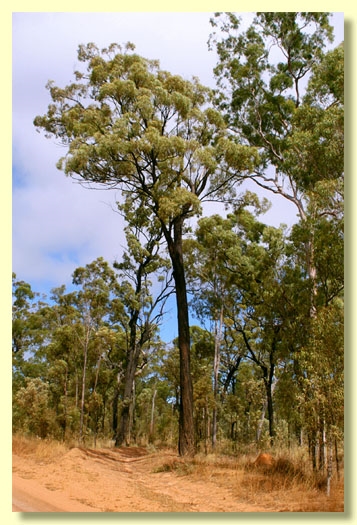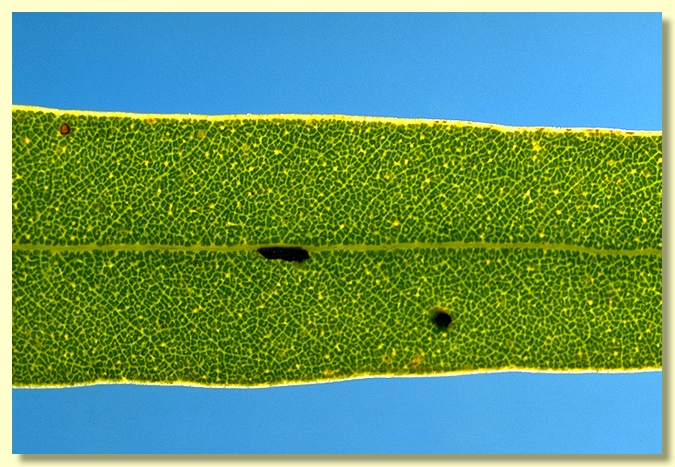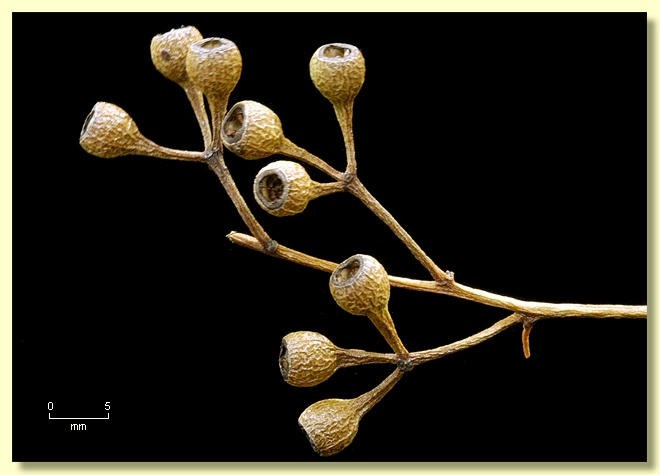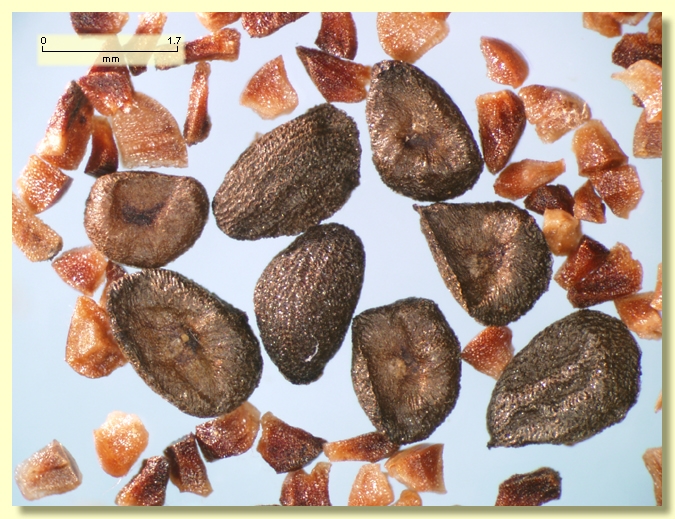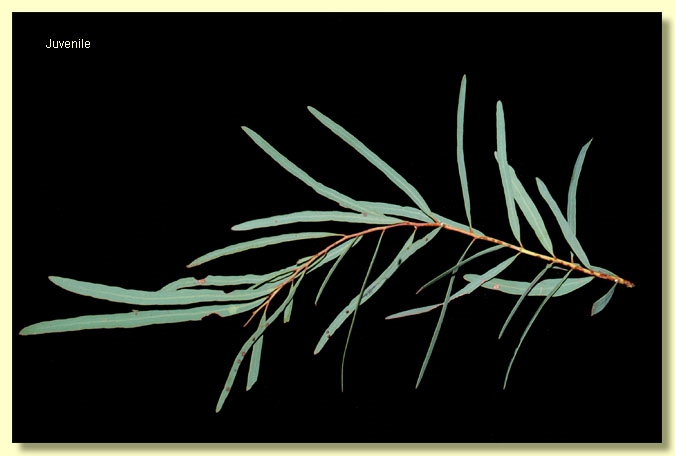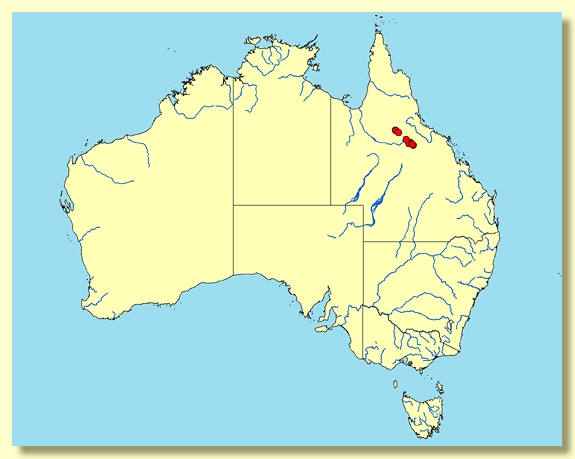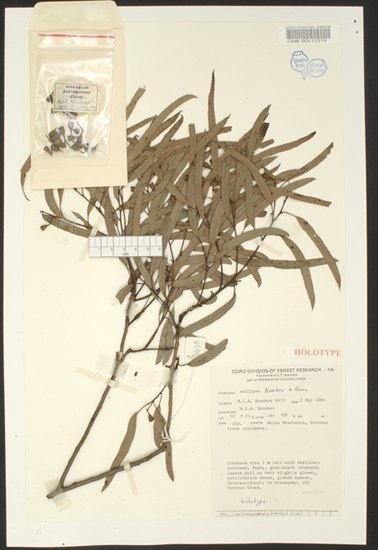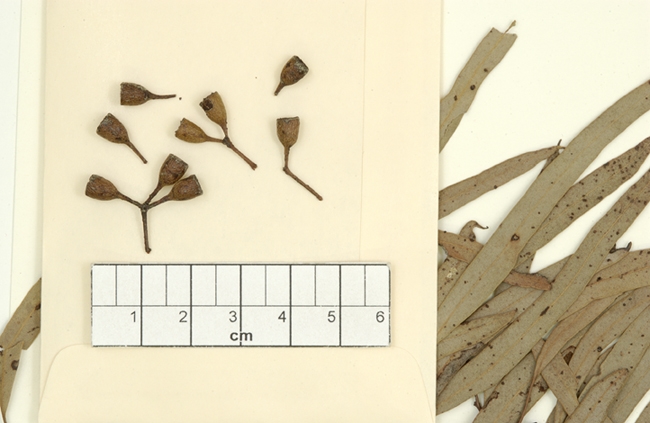Euclid - Online edition
Eucalyptus exilipes
Eucalyptus | Symphyomyrtus | Adnataria | Apicales | Siderophloiae | Subglaucae
Tree to 35 m tall. Forming a lignotuber.
Ironbark to small branches, dark grey or black.
Juvenile growth (coppice or field seedlings to 50 cm): stem rounded in cross-section; juvenile leaves sub-opposite to alternate, petiolate, linear, 2.5–10 cm long, 0.2–0.6(0.7) cm wide, dull grey-green to blue-grey.
Adult leaves alternate, petiole 0.5–1 cm long; blade linear to narrowly lanceolate, 5–13 cm long, 0.4–1 cm wide, base tapering to petiole, concolorous, dull or rarely slightly glossy, green or sometimes bluish green, side-veins at an acute or sometimes wider angle to midrib, densely reticulate, intramarginal vein confluent with the margin, oil glands mostly intersectional and sparse.
Inflorescence terminal compound or axillary compound or axillary single umbels, peduncles 0.5–1.1 cm long, buds 7 per umbel, pedicels 0.3–0.8 cm long. Mature buds narrowly ovoid to fusiform, 0.5–0.6 cm long, 0.2–0.3 cm wide, green to yellow, smooth, scar present, operculum conical, stamens usually irregularly flexed, anthers adnate, cuboid, dehiscing by broad lateral pores or slits, style long, stigma blunt or pin-head shaped, locules 3 or 4, the placentae each with 4 vertical ovule rows. Flowers white.
Fruit pedicellate (pedicels 0.3–0.8 cm long), cup-shaped to truncate-globose, 0.4–0.6 cm long, (0.3)0.4–0.6 cm wide, usually longer than wide, disc level to descending, valves 3 or 4, usually visible near rim level.
Seeds brown or grey, (1)1.8–2 mm long, ovoid or flattened-ovoid or pointed at one end, dorsal surface shallowly pitted, hilum ventral.
Cultivated seedlings (measured at ca node 10): cotyledons reniform; stems square in cross-section; leaves always petiolate, opposite for 2–7 nodes then alternate, linear to linear-lanceolate, 5.5–8.7 cm long, 0.6–1 cm wide, base tapering, dull, green, discolorous. Seedling much branched.
Flowering has been recorded in July and August.
A medium-sized to tall ironbark tree from north Queensland. Of restricted distribution and thus far known only from a few sites in the Lauderdale area south of Pentland, in the Burra Range – White Mountains area west of Pentland, the Blackbraes National Park area midway between The Lynd and Hughenden and possibly two disjunct populations, one south of Mutchilba in the Stannary Hills area and another on Cape York Peninsula along the Battle Camp road, north-west of Cooktown. (The population in the Stannary Hills area is regarded by others as being distinct from E. exilipes and has been referred to as Eucalyptus sp. "Stannary Hills". The specimens from the Battle Camp area were given the manuscript name E. pomadora by other eucalypt botanists, because the crushed leaves smelt like apples.)
Eucalyptus exilipes is characterised by its crowded, very narrow, linear juvenile leaves, its linear to narrowly lanceolate adult leaves where the intramarginal vein is confluent with the margin of the leaf or occasionally just removed from it, its narrowly ovoid to fusiform buds on slender pedicels and its relatively long conical operculum. The fruit are slightly longer than wide with valves visible at rim level.
It is very closely related to E. crebra and differs only marginally by the long slender pedicels.
Within its broad area of occurrence, E. exilipes could be confused with E. cullenii, E. granitica and E. whitei. All four species have relatively narrow linear to lanceolate juvenile leaves. E. cullenii and E. granitica can be separated by having buds with rounded to bluntly conical opercula, and E. cullenii is further separated by having hemispherical fruit with a broad flat disc. E. whitei is separated by its glaucous buds and broader juveniles, always wider than 2 cm in E. whitei but never wider than 0.6 cm in E. exilipes.
Eucalyptus exilipes: Latin exilis, slender and pes, foot, referring to the very slender pedicels.

